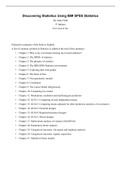Resumen
Summary Discovering Statistics Using IBM SPSS Statistics - 5th edition - Andy Fields
- Grado
- Institución
- Book
VERY extensive summary of the whole book in ENGLISH. A list of common symbols in Statistics is added at the end of this summary Grade received:9.0
[Mostrar más]




